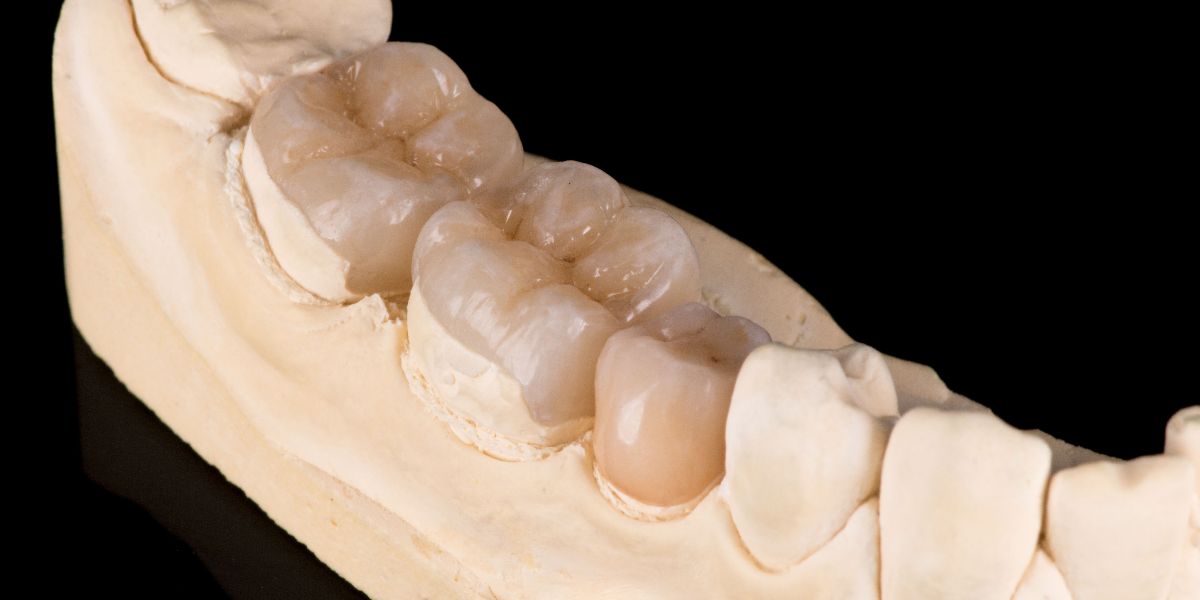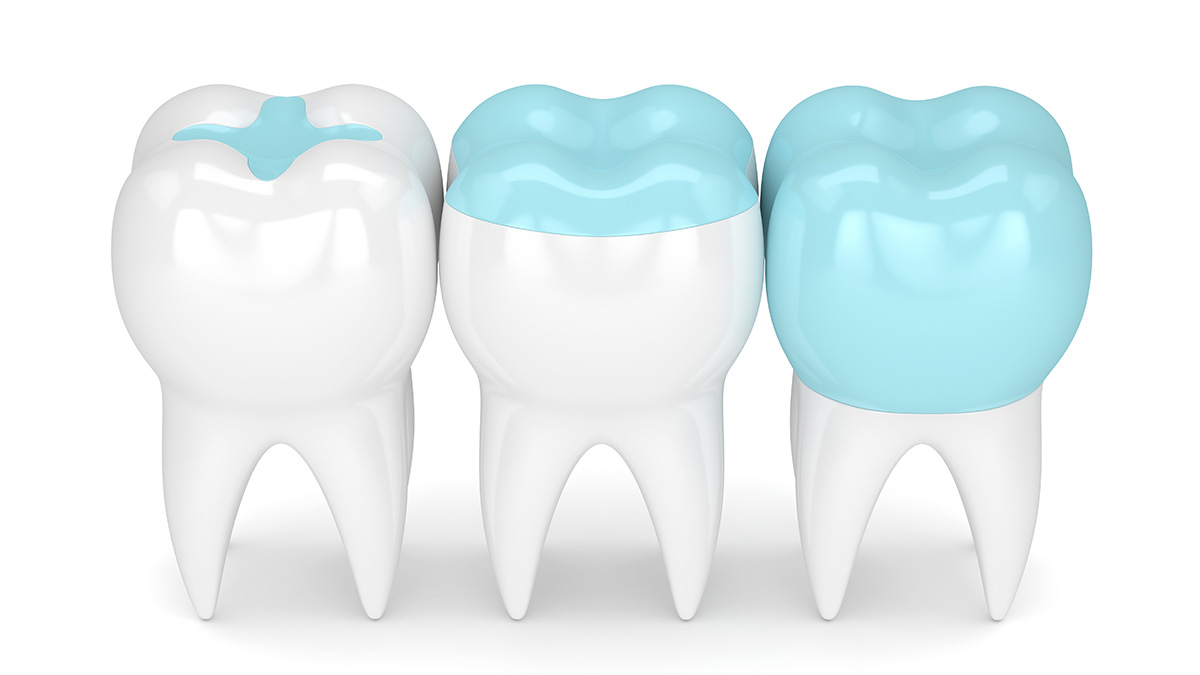Inlays, onlays, and overlays dental restorations
Discover everything about inlay, onlay, and overlay fillings, modern dental techniques that restore the functionality and aesthetics of damaged teeth.
What Are Inlay Fillings?
Inlay fillings are precise dental restorations designed to restore the inner part of a tooth damaged by decay or fracture. They are created outside the mouth in a dental laboratory from materials such as porcelain, composite, or gold, ensuring perfect fit and aesthetic harmony with natural teeth. Inlay fillings preserve more healthy tooth tissue compared to traditional fillings, providing a long-lasting restoration with high aesthetics and functionality. Regular oral hygiene and dental check-ups ensure their longevity.

What Are Onlay Fillings?
Onlay fillings are advanced dental restorations intended for repairing a tooth when the damage involves one or more cusps. Unlike inlay fillings that fit within the surface of the tooth, onlay fillings cover a larger portion of the tooth, providing stronger support and stability. They are fabricated in a dental laboratory from materials such as porcelain, composite resins, or gold, ensuring durability and aesthetic appeal. Onlay fillings allow for the preservation of a significant amount of natural tooth tissue, offering a long-lasting and functional solution for tooth restoration. With regular maintenance, including brushing, flossing, and dental visits, onlay fillings maintain their functionality and aesthetics.
What Are Overlay Fillings?
Overlay fillings represent a type of dental restoration designed to restore teeth that are significantly damaged or weakened. Overlay fillings cover and protect a larger portion of the tooth or even the entire chewing surface, providing intensive support and strengthening the tooth structure. They are made from porcelain, composite resins, or gold in a dental laboratory, offering high levels of aesthetics and durability. Overlay fillings are ideal for teeth that have undergone extensive decay or fractures and can serve as an alternative to dental crowns when it is important to preserve as much natural tooth tissue as possible. Regular care, including brushing, flossing, and regular dental check-ups, is essential for maintaining the health and longevity of overlay fillings.

Benefits of Inlay, Onlay, and Overlay Fillings
- Precision and Adaptability of Inlay, Onlay, and Overlay Fillings
Inlay, onlay, and overlay restorations are made based on precise impressions of your teeth, allowing for a high level of customization and precise fit. This results in a restoration that looks and feels like a natural tooth.
- Preservation of Healthy Tooth Tissue
These restorations allow for maximum preservation of natural tooth tissue, which is crucial for maintaining long-term tooth health, with minimal drilling compared to traditional crowns.
- Durability and Longevity of Onlay, Overlay, and Inlay Fillings
Materials such as porcelain, ceramics, and composite resins are known for their durability and resistance to abrasion, making these restorations a long-lasting solution that can withstand chewing forces.
- Aesthetics of Onlay, Overlay, and Inlay Fillings
They can be made from materials that mimic the appearance of natural teeth, allowing the restorations to blend seamlessly into your smile and make them almost invisible.
- Improvement of Chewing Function
Restorations help restore the proper structure of the tooth, thereby improving chewing function and providing key support for restoring back teeth.
- Prevention of Further Damage
By stabilizing and protecting a weakened or damaged tooth from further decay or fracture, inlay, onlay, and overlay restorations prevent the need for more complex procedures.
- Easy Maintenance of Onlay, Overlay, and Inlay Fillings
With regular brushing, flossing, and dental visits, maintaining the hygiene of these restorations is simple, similar to natural teeth.
The Process of Making Inlay, Onlay, and Overlay Fillings
The process of creating inlay, onlay, and overlay fillings is detailed and requires precision to ensure the restoration fits perfectly and restores the function and aesthetics of the damaged tooth. The steps are as follows:
- Diagnosis of Tooth and Oral Health, and Planning
The first step includes a thorough diagnosis of the condition of the tooth and oral cavity. The dentist uses visual examination, digital images, and possibly 3D scanning to assess the extent of damage and determine which type of restoration (Inlay, Onlay, or Overlay) best suits the patient’s needs.
- Preparation of the Tooth for Inlay, Onlay, or Overlay Fillings
Preparation of the tooth is a crucial step where the dentist removes damaged tissue and old filling material, shaping the tooth to accommodate the inlay, onlay, or overlay restoration. The goal is to remove all decay while preserving as much healthy tooth tissue as possible.
- Taking Impressions of the Teeth for Inlay, Onlay, or Overlay Fillings
After preparation, the dentist takes a precise impression of the tooth and surrounding area. The impression can be traditional, using dental putty, or digital, using an intraoral scanner. The impression is sent to a dental laboratory where a custom inlay, onlay, or overlay filling is made.
- Making Temporary Inlay, Onlay, or Overlay Fillings
While the permanent inlay, onlay, or overlay restoration is being made, a temporary filling or crown may be placed to protect the prepared tooth and allow normal function.
- Creating the Inlay, Onlay, or Overlay Fillings
In the dental laboratory, based on the impression, an inlay, onlay, or overlay restoration is created using the chosen material. The technician ensures that the color, shape, and size of the restoration perfectly match the patient’s natural teeth.
- Placing the Inlay, Onlay, or Overlay Fillings
When the inlay, onlay, or overlay restoration is ready, the patient returns to the dental office where the dentist checks the fit, color, and bite. If everything is satisfactory, the inlay, onlay, or overlay restoration is permanently cemented in place using specialized dental cement.
- Final Check and Adjustment of Inlay, Onlay, or Overlay Fillings
After placing the inlay, onlay, or overlay fillings, the dentist performs a final check to ensure the restoration is comfortable and functional. Adjustments can be made for perfect fit and comfortable feel.
- Care and Maintenance Instructions for Inlay, Onlay, or Overlay Fillings
The patient receives detailed instructions on how to care for the new inlay, onlay, or overlay restoration, including recommendations for brushing, flossing, and regular dental check-ups.
Choosing the Material for Your Inlay, Onlay, or Overlay Fillings
Materials such as porcelain, composite resins, or gold are chosen based on aesthetic preferences, functional needs, and financial considerations.
Care and Maintenance of Inlay, Onlay, and Overlay Restorations
Basic oral hygiene, such as regular brushing and flossing, is essential for maintaining the health of inlay, onlay, or overlay restorations. Regular dental check-ups and professional cleanings help detect and address any issues promptly.
Avoiding excessive pressure on restored teeth, such as chewing hard objects, can also help preserve your inlay, onlay, and overlay fillings.
Scheduling Consultations for Inlay, Onlay, and Overlay Restorations
If you are considering inlay, onlay, or overlay restorations, scheduling a consultation is the first step toward restoring and protecting your smile. Our team is here to answer all your questions and help you choose the best solution for your needs.


